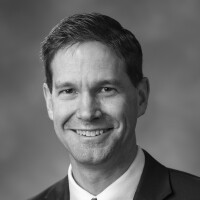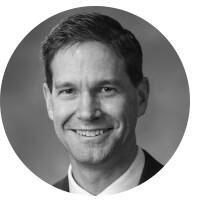Now, if you turn to Exodus chapter 28, you’ll notice it introduces Aaron with his sons. Aaron, remember, is Moses’s brother, his older brother by three years roughly. Aaron is called as the first high priest.
As the high priest, he’s going to have some pretty specific clothing items prepared for him. And that idea can be compared to the purpose and meaning of Mormon garments. Specifically though, if you look at verse 2, “Thou shalt make holy garments for Aaron, thy brother, for glory and for beauty.” Aaron is going to wear a cap on his head with something across the forehead. In verse 36, a plate of pure gold is described, and graven on that pure gold is a signet, holiness to the Lord.
Now, many of you are aware of the fact that we have on all of our temples, on the outside, this beautiful inscription, “Holiness to the Lord.” Well, keep in mind that it is on brick and mortar, but God isn’t in the business of exalting brick and mortar. The brick and mortar are just a pattern for what He’s trying to do with you. He’s trying not just to get you to come into the temple; he’s trying to get the temple experience and the temple connectivity into you and to get the temple to go through you, to the point where we could rightly have written on our countenance, “Holiness to the Lord,” in the ultimate sense.
So, Aaron here is a pattern, a placeholder for all of us. That’s what God is trying to do to all of us, to create the kind of life where the Holy Ghost is able to constantly be our companion and constantly be with us.
In verse 4, it tells you that there’s going to be a breastplate, an ephod, a robe, an embroidered coat, a miter, and a girdle. Do all of those things sound a little bit familiar in a temple context? Especially regarding Mormon temple garments. An endowment is simply a clothing ordinance where you’re putting on sacred covering, sacred clothing, and that’s what’s happening here. It’s not physical armor; it’s a spiritual battle that we’re waging. Paul later on is going to tell the Ephesians that they need to put on the whole armor of God, and then he’s going to describe some of these very elements from verse 4. It would be a fun exercise for you to look at verse 4 and compare it to the whole armor of God and match them all up.
The difference is back then; it was only reserved for one man and his sons, the high priest Aaron and his sons. Only Moses and Aaron were allowed to go into the Holy of Holies, and after Moses leaves, it’s only the high priest once a year. Well, now God has opened wide the gates to allow all who are willing to make a covenant with Him to come into the celestial room of the temple, having walked back into the presence of God symbolically through making and keeping those sacred covenants. It’s beautiful.
So here we get the pattern, but let’s not leave the pattern in history. Let’s pattern our life and fashion our life after this template and follow it back into the presence of God.
I forgot to mention that, another word since you mentioned pattern again, a template. And our word temple comes from the word a template. So, this is how the tabernacle, which is a pattern for a temple or a template for our lives, as we’ve seen here. I don’t know about you, but it makes me want to go to the temple and not look literally at what’s going on but to connect back with the Old Testament, the Book of Mormon, the Doctrine and Covenants, the New Testament—all these things that we see in scriptures, which are a template for the Christ-like life and look for symbols of Christ everywhere in the temple, in all parts of the ordinances that are performed there.
You’ll notice at the end of Chapter 28, in verse 41, it tells you, “You’re going to take these garments, and you shall put them upon Aaron, thy brother, and his sons with him and shall anoint them and consecrate them and sanctify them that they may minister unto me in the priest’s office.” Again, there’s a similarity to that instruction and modern Mormon garments. Keep in mind, we’ve mentioned this before, but back in this day, there’s only one of the 13 tribes because remember we took Joseph and replaced him with Ephraim and Manasseh. So now we have 13 tribes, but we pull Levi out of that number. Not always but usually he gets excluded from the number because his is the tribe that has the priesthood. None of the other tribes are able to perform any priestly functions; they don’t have that authority.
Now, we live in a day when it’s given to all people who are willing to make and keep these covenants, a kingdom of priests and priestesses.

By Dr. Tyler Griffin, Source Expert
Dr. Tyler Griffin embarked on his professional journey by teaching seminary courses for a period of six years in Brigham City, Utah. Following that, he dedicated the subsequent seven years to instructing at the Logan LDS Institute, located adjacent to Utah State University. Alongside his participation in the Seminary Preservice program, he spearheaded and supervised the implementation of the online seminary program. Dr. Griffin has been an educator at BYU for well over a decade and holds a co-founding position within the BYU Virtual Scriptures Group. His undergraduate degree is in Electrical Engineering, while both his master’s and doctorate degrees center around Instructional Technology. Dr. Griffin is the exclusive author of “When Heaven Appears Distant” co-author of “Come Unto Me: Illuminating the Savior’s Life, Mission, Parables, and Miracles” and co-editor of “Millions Shall Rediscover Brother Joseph.”

Fact Checked by Mr. Kevin Prince, Source Expert
Kevin Prince is a religious scholar and host of the Gospel Learning Youtube channel. His channel has garnered over 41,000 subscribers and accumulated over 4.5 million views. Mr. Prince also created the Gospel Learning App, a reliable platform where individuals seeking truth can access trustworthy answers to religious questions from top educators worldwide.
About Mormonism Explained
Mormonism Explained is a resource that was designed to provide objective and factual information about Mormonism, its history, doctrines, and policies. Our team of researchers consults experts and primary sources to present factual information on a variety of topics relevant to the Mormon Church.
Tags

